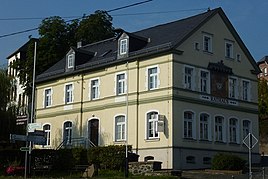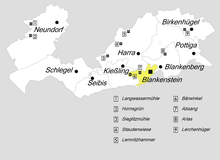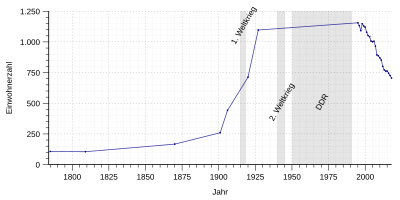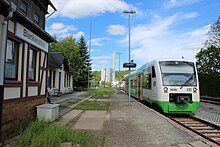Blankenstein (Rosenthal am Rennsteig)
|
Blankenstein
Rosenthal am Rennsteig municipality
|
|
|---|---|
| Coordinates: 50 ° 24 ′ 7 ″ N , 11 ° 42 ′ 1 ″ E | |
| Height : | 450 m |
| Incorporation : | 1st January 2019 |
| Postal code : | 07366 |
| Area code : | 036642 |
|
Location of Blankenstein in the Saale-Orla district
|
|
|
town hall
|
|
Blankenstein is a place in the Saale-Orla district in Thuringia and is the seat of the unified community Rosenthal am Rennsteig . It lies directly on the state border with Bavaria in the area where the Selbitz flows into the Saale . Blankenstein is the end of the Rennsteig hiking trail and the trains from Saalfeld .
Neighboring communities
Nearby places are Blankenberg and Harra , which also belong to Rosenthal am Rennsteig, as well as the city of Lichtenberg and the municipality of Issigau in the Bavarian district of Hof .
history
1258 is given as the year Blankenstein was first mentioned, but there is no documentary evidence for this. In 2008 the town's 750th anniversary was celebrated. In the literature, the years 1392 or 1444 are given for the first documentary mention.
Blankenstein manor
The emergence of the place Blankenstein is closely connected with the manor Blankenstein . This was first mentioned in a document in 1392 and was in the possession of the Lords of Blankenberg . These also owned the manors in Harra and Kießling . In a document dated May 10, 1566, an Asmus von Blankenberg is mentioned as the owner of the manor who had acquired the Hammergut from Friedrich Fischer from Saalfeld. Around 1600 the estate fell to the rulers of the Reuss younger line . The Russian Prince Heinrich Posthumus sold the Blankenstein manor in 1605 to the Dresden citizen Jacob Reuter. A short time later, the estate was transferred to Christoph von Waldenfels on Lichtenberg .
In 1688 Heinrich von der Tann acquired the Blankenstein estate for 5250 guilders. In the same year, the Schleizer Oberamtmann Heinrich Adam Lauterbach appeared as the owner of the property. He had also acquired the Eichensteiner Rittergut from superintendent Gabriel Hartung from Schleiz and thus combined the two estates, which lasted until Eichenstein was incorporated into the Kingdom of Bavaria in 1830.
Blankenstein from the 17th to the 21st century
At the beginning of the 19th century, the landlords in Harra made a room in their manor house available as a classroom for the school children from Blankenstein. Over time, however, this room became too small for the growing number of school children. In 1852, the Blankenstein teacher Zeiß sent a petition to the state parliament asking for a school house to be built. In 1857, the manor owner Götze offered the Blankenstein community the house that had previously housed the school for sale for 100 thalers. After the community had acquired the property, they had the old house demolished and built a new schoolhouse on the same site, which was inaugurated on December 9, 1857. Because of the increasing number of pupils, this school also became too small over time and in 1890 planning began for the construction of a new school, which in 1892 in the presence of the Hereditary Prince and later Prince Heinrich XXVII. , Reuss younger line, was inaugurated. The school building, which is still in use today, was built in 1926.
Because of its location on the German-German border , which was created as a result of the Potsdam Agreement , the place was in the border area. This meant that hardly any tourism could develop there. After German reunification , parts of the border fortifications were preserved.
On January 1, 2019, the community of Blankenstein merged with the communities of Birkenhügel , Blankenberg , Harra , Neundorf , Pottiga and Schlegel to form the unitary community of Rosenthal am Rennsteig . All of the communities mentioned had belonged to the Saale-Rennsteig administrative community since 1994 , which was dissolved at the same time.
Mining and metallurgy
From the Middle Ages
In the area bordered by Lemnitz , Saale and Selbitz there were numerous heaps and pings , including the Engel-Grube, also called Absanger Zug or Archangel, which was in operation well before the Thirty Years War and stretched from the Selbitz to the northwest to the Goose Hill at Harra extended.
In 1371 a hammer mill in Blankenstein was mentioned in addition to the iron mines and the hammer mill in Blankenberg. In 1528 the owner of the hall hammer at Pottiga , Nicol Oberländer, received the hammer on the Selbitz from Hans von Reitzenstein on Blankenberg as a fief.
Tax hammer mill
In 1606, the Blankenstein manor owner Jakob Reuter asked the Reussian rulers to be allowed to build a new hammer mill in the village. He gave his approval on the basis of hoped-for profits and supported the construction by concluding a contract with the Lords of Reitzenstein, as the construction affected their property. The contract included that the water of the Saale was dammed and that the confluence of the Selbitz was relocated a little upstream. After that, the hammer mill was built on the grounds of the manor and was named "the great hammer" as early as 1609. A few years after the beginning of the Thirty Years War, the hammer mill came to a standstill in 1622.
In 1799 Adam Daniel von Püttner bought the manor on Issigau and, with the help of the owners of the Blechschmidtenhammer, Johann Wilhelm Seidel and Johann Heinrich Dittmar, built a new hammer mill on the same site, which was completed on September 9, 1802. In 1829 the work was sold to the brothers Johann Friedrich and Johann Heinrich Heynisch from Lobenstein for 7,000 Rhenish guilders . This built in place of the hammer mill, a wool combing and worsted - spinning , which was in operation until the year 1861st On May 7, 1865, the spinning mill burned down to the ground, but was rebuilt a short time later, slightly modified. An art mill was set up on the lower floor and a carded yarn spinning mill on the upper floor. Later there was a vigoga spinning mill in the rooms , in which fabrics were made from cotton and sheep wool. In 1876 a fire destroyed all buildings.
On July 2, 1881, the coal mine owner and mine director Gotthelf Anton Wiede from Bockwa near Zwickau bought the fire ruins for 31,000 marks in order to set up an industry that was still young at that time, wood grinding and cardboard manufacture.
Population development
Development of the population (from 1994: as of December 31):
|
|
|
|
|
|
- Data source from 1994: Thuringian State Office for Statistics
politics
Municipal council
Since the 2014 municipal council elections , the council has been composed as follows:
- Free voters Blankenstein - Christian Democratic Union of Germany : 6 seats
- The left : 2 seats
mayor
In the mayoral elections on June 5, 2016, Peter Keller (WG FWB-CDU) was elected mayor with 68.4% of the vote.
religion
The place Blankenstein belongs to the Evangelical-Lutheran parish Harra in the church district Schleiz ( EKMD ) and to the Catholic deanery Weimar-Arnstadt in the diocese of Erfurt and does not have its own church. In the past, however, there was a small chapel in the village where the evangelical pastor of Harra preached every other Sunday. A little church in Blankenstein is mentioned in a document from 1566. On the other hand, at the end of the 16th century, a Hans Oberlander was asked to clear the old chapel, which he used as a stable, because a visitation in 1601 wanted to restore it, but this failed.
Economy and Infrastructure
railroad
Blankenstein can be easily reached by train from Saalfeld via the Sormitztalbahn and the Oberlandbahn . The continuation to Marxgrün and Hof in Bavaria has been shut down since the division of Germany .
- History of rail traffic in Blankenstein
Since the paper mill , which has been based in the town since 1881, has grown steadily, there were great difficulties in bringing the raw materials required for production to Blankenstein and the finished products to the markets. Horse-drawn carts had to laboriously drive to the next rail connection in Hof , 25 kilometers away , in order to handle the handling of goods. The wish for a connection to the railway network seemed to be fulfilled when the news from Dresden arrived on December 6, 1886 that the Saxon state parliament had approved the Schönberg – Hirschberg railway with a narrow-gauge junction to Blankenstein.
No sooner had the surveying of the route started than Prussia put an end to the construction project. Prussia planned a standard gauge railway Triptis – Lobenstein – Blankenstein with the continuation to Marxgrün. The decisive factor for the Prussian variant may have been that, unlike Saxony, no interest guarantees were required from the Reussian state. The first locomotive did not arrive in Blankenstein until August 15, 1897.
Road traffic
The federal highway 9 runs about five kilometers from Blankenstein .
bus
You can reach Blankenstein by bus
- from Schleiz - Birkenhügel - Blankenberg - Blankenstein
- from the direction of Lobenstein - Saaldorf - Frössen - Blankenberg - Blankenstein
- from the direction of Lobenstein - Harra - Blankenstein
With the lines 620, 640 and 720 of the KomBus Blankenstein has connections to the cities of Bad Lobenstein , Ebersdorf , Naila , Schleiz , Tanna and Ziegenrück .
Pulp and paper mill Rosenthal
Wiedes Papierfabrik Rosenthal, built at the end of the 19th century, became today's Zellstoff- und Papierfabrik Rosenthal (ZPR), one of the most modern Kraft pulp mills in Europe with around 450 employees. It is based in Blankenstein and shapes the townscape.
Memorials
A stone stele near the train station has been commemorating the victims of the death march of concentration camp prisoners in spring 1945 since 1985 .
Culture and sights
Hiking and biking trails
Blankenstein is the starting point and destination of the Rennsteig , the Frankenweg , the Vogtland-Erzgebirge Ridge Trail and the Franconian Mountain Trail . At the train station, on the Saale-Orla hiking trail , there is a monument to the Rennsteig hiker. The Höllental with its numerous hiking trails and the Muschwitztal with its hiking trail can be reached on foot from Blankenstein.
Blankenstein is also on the Rennsteig cycle path and the Saale cycle path .
Sports
Blankenstein is the home of the SG Rosenthal Blankenstein football club.
literature
- Robert Hansel: Blankenstein-Rosenthal on the Saale. Brief history of the village of Blankenstein and development of Wiede's paper mill Rosenthal. Chr. Teich's bookstore, Lobenstein (Reuss) 1921.
Web links
- Blankenstein website
- Page about Blankenstein on the homepage of the community Rosenthal am Rennsteig
Individual evidence
- ^ Wolfgang Kahl : First mention of Thuringian towns and villages. A manual. 5th, improved and considerably enlarged edition. Rockstuhl, Bad-Langensalza 2010, ISBN 978-3-86777-202-0 , p. 35.
- ↑ Thuringian Law and Ordinance Gazette No. 14/2018 p. 795 ff. , Accessed on May 20, 2019
- ↑ http://www.wahlen.thueringen.de/datenbank/wahl1/wahl.asp?wahlart=GW&wJahr=2014&zeigeErg=GEM&auswertung=1&wknr=075&gemnr=75004&terrKrs=&gemteil=000&buchstabe=&Langname=x&wahlvorschlag=&sort=&druck=&XLS=&anzahlH = -3 & Non_existing = & x_vollbildDatteil = & optik = & aktuell = & ShowLand = & ShowWK = & ShowPart =
- ↑ Brief information on vg-saale-rennsteig.de
- ↑ Allocation of the parish
- ↑ http://www.kirchenkreis-schleiz.de/pfarraemter.html
- ^ Website SG Hirschberg / Rosenthal-Blankenstein








